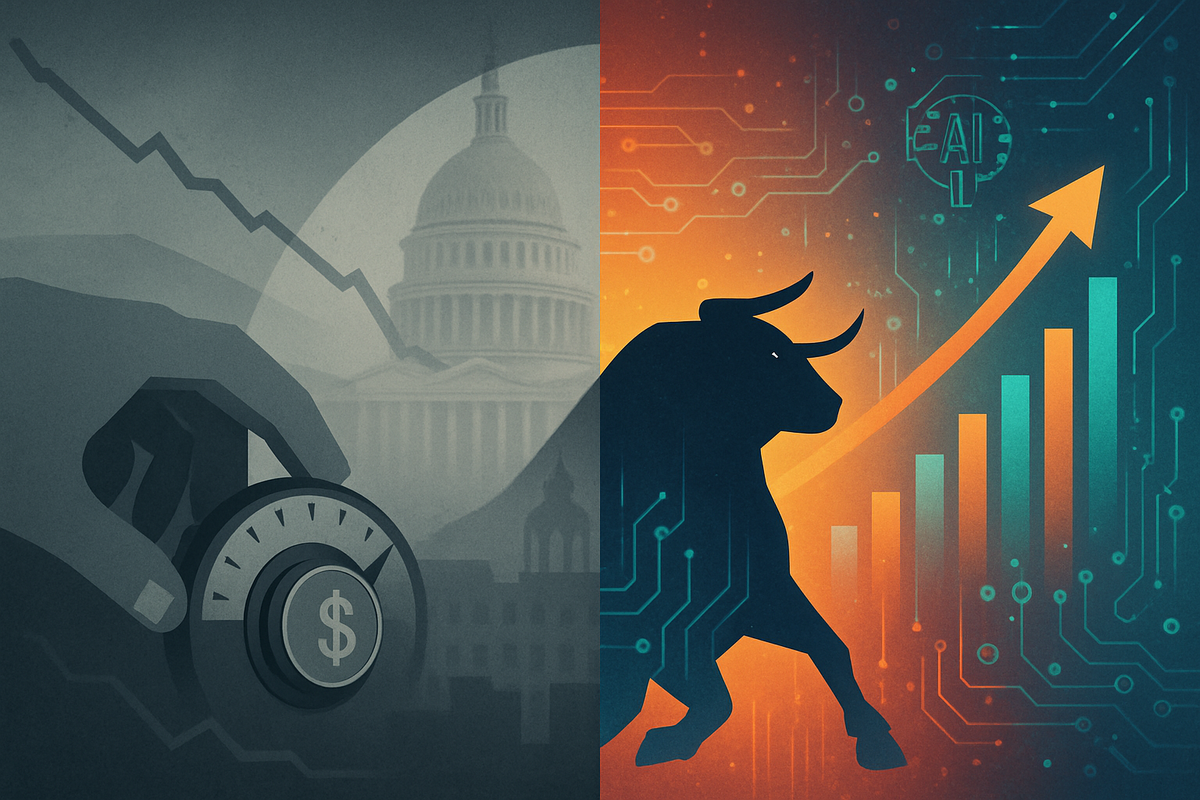
October 10, 2025 – In a financial landscape increasingly defined by paradox, Wall Street is exhibiting a complex and somewhat counterintuitive reaction to the latest economic sentiment data. Despite a persistently grim consumer outlook and the shadow of an ongoing federal government shutdown, equity markets, particularly the technology sector, have demonstrated remarkable resilience and continued advancement. This divergence highlights a market profoundly influenced by expectations of future Federal Reserve interest rate cuts, even as current economic indicators paint a less optimistic picture for the everyday consumer.
The immediate implications are significant: investors appear to be operating on a "bad news is good news" principle, where signs of economic softening are interpreted as strengthening the case for monetary easing. This sentiment is fueling targeted market advances, yet it also underscores a growing disconnect between broad consumer confidence and the performance of specific market segments, raising questions about the sustainability and breadth of the current rally.
Detailed Coverage of the Event: Navigating the Data Vacuum
The focal point of Wall Street's attention on October 10, 2025, was the release of the University of Michigan's preliminary Consumer Sentiment Index for October. Registering a grim 55, a marginal decrease from September's 55.1, the index reflected a consumer outlook near historical lows, primarily driven by concerns over "pocketbook issues like high prices and weakening job prospects." While slightly better than market expectations, the figure confirmed a deeply subdued consumer mood.
This consumer sentiment data has taken on amplified importance due to a prolonged U.S. federal government shutdown, which has created a significant data vacuum. Crucial official economic indicators, including the nonfarm payrolls report and the Consumer Price Index (CPI) inflation data, remain delayed, compelling investors and analysts to place greater weight on available "soft data" such as consumer surveys. Adding to the economic backdrop, the September private payrolls report indicated job losses, marking the weakest reading since March 2023, further reinforcing perceptions of a softening labor market.
Despite this confluence of negative news—grim consumer sentiment, a government shutdown, and signs of labor market weakness—Wall Street's immediate reaction on October 10, 2025, was mixed but largely resilient. The Dow Jones Industrial Average experienced a slight decline, but the S&P 500 (SPX) recorded modest gains of 0.13%, and the technology-heavy Nasdaq Composite (IXIC) advanced by 0.16%, remarkably reaching a new record high. This resilience suggests a market driven by factors beyond immediate economic hardship, primarily the strong expectation of future Federal Reserve interest rate cuts.
Companies Poised for Gains or Losses in a Shifting Landscape
In this environment, where "bad news is good news" and monetary easing expectations drive market sentiment, certain companies and sectors are positioned to either win or lose. The technology sector, in particular, has emerged as a clear beneficiary. Companies like Nvidia (NASDAQ: NVDA) have been notably in focus, hitting new all-time highs, driven by robust demand related to artificial intelligence (AI). This "AI-driven momentum" is expected to continue benefiting chipmakers, software providers, and cloud computing giants. Other tech stalwarts such as Microsoft (NASDAQ: MSFT), Amazon (NASDAQ: AMZN), and Alphabet (NASDAQ: GOOGL) are likely to see sustained investor interest as growth-oriented stocks tend to perform well in anticipation of lower interest rates, which reduce borrowing costs and increase the present value of future earnings.
Conversely, sectors more directly exposed to consumer spending and economic sensitivity could face headwinds. Retailers, hospitality, and certain manufacturing companies might struggle if persistently low consumer confidence translates into reduced spending. Companies like Target (NYSE: TGT) or Starbucks (NASDAQ: SBUX), which rely heavily on discretionary consumer spending, could see slower growth or even declines. Furthermore, businesses with high debt loads or those that are less agile in adapting to shifting economic conditions might find themselves under pressure, especially if the government shutdown prolongs, creating uncertainty and hindering business operations.
The real estate sector, while potentially benefiting from lower interest rates in the long run, could experience short-term volatility. Companies involved in commercial real estate or home construction, such as PulteGroup (NYSE: PHM), might face a mixed bag of opportunities and challenges. While lower mortgage rates could stimulate demand, the overall economic uncertainty and weakening job prospects could deter potential buyers. Investors will be closely watching earnings reports from these companies to gauge the true impact of the current economic climate and sentiment data.
Wider Significance: A New Paradigm for Market Interpretation
This current market dynamic represents a significant shift in how Wall Street interprets economic data and its broader significance. Historically, grim consumer sentiment and government shutdowns would typically trigger widespread market unease. However, as of October 2025, the market's primary focus has pivoted to the Federal Reserve's monetary policy. The belief that weaker economic data will prompt the Fed to continue lowering interest rates has created a "buying the dip" mentality, where temporary pullbacks are seen as opportunities. This phenomenon suggests a new paradigm where the expectation of liquidity trumps immediate economic realities for specific market segments.
The potential ripple effects extend beyond individual companies. This concentrated "AI-driven momentum" in technology, while strong, may eventually spill over into other sectors as demand for data center infrastructure accelerates, potentially benefiting energy and construction companies. However, this also poses a risk: if the anticipated rate cuts do not materialize as aggressively as the market expects, or if the economic downturn deepens beyond the Fed's ability to stimulate, the current rally could prove fragile. Regulatory bodies might also begin to scrutinize the growing disconnect between market performance and underlying economic health, potentially leading to calls for increased transparency or revised economic reporting during government shutdowns.
Historically, periods of government shutdowns have often led to increased market volatility and investor uncertainty, as seen in previous shutdowns in 2013 and 2018-2019. However, the current situation, coupled with strong expectations for monetary easing, presents a unique scenario. The reliance on "soft data" in the absence of official statistics could also lead to misinterpretations or delayed reactions if the underlying economic reality differs significantly from what sentiment surveys suggest. This highlights the evolving nature of market drivers and the increasing influence of central bank policy expectations.
What Comes Next: Navigating Uncertainty and Opportunity
In the short term, the market's trajectory will largely depend on the resolution of the federal government shutdown and any subsequent official economic data releases. A swift resolution could alleviate some uncertainty, but the delayed data might still reveal a more challenging economic picture than currently perceived. Investors will be keenly watching for any signals from the Federal Reserve regarding its interest rate policy. Any indication that the Fed might be less aggressive with rate cuts than anticipated could trigger a market correction, especially in the high-flying tech sector. Conversely, continued dovish signals will likely sustain the current market advances.
Long-term possibilities include a sustained bull market driven by technological innovation and accommodative monetary policy, assuming economic conditions stabilize and corporate earnings remain robust. However, a prolonged period of low consumer confidence coupled with a weakening labor market could eventually impact corporate profitability, even for resilient tech companies. Strategic pivots for businesses might include a renewed focus on cost efficiencies, diversification of supply chains to mitigate geopolitical risks, and increased investment in automation and AI to enhance productivity in an uncertain labor market.
Market opportunities may emerge in sectors that are currently undervalued but stand to benefit from a eventual economic recovery or specific technological advancements. Challenges include navigating persistent inflation, potential global economic slowdowns, and the inherent volatility of a market heavily reliant on sentiment and central bank actions. Potential scenarios range from a "soft landing" where the economy gradually improves with the help of rate cuts, to a more pronounced downturn if current headwinds persist or worsen. Investors should prepare for continued market dynamism and potential shifts in leadership among sectors.
Comprehensive Wrap-up: A Market in Transition
The current financial climate, as of October 10, 2025, is characterized by a striking dichotomy: a resilient, advancing stock market, particularly in technology, set against a backdrop of grim consumer sentiment and a disruptive government shutdown. The key takeaway is the profound influence of anticipated Federal Reserve interest rate cuts, which have become the primary driver of investor confidence and market advances, overshadowing immediate economic concerns. This "bad news is good news" mentality has propelled certain growth stocks to new highs, while other sectors face uncertainty.
Moving forward, the market will remain highly sensitive to any developments regarding the government shutdown, the release of delayed economic data, and, most critically, the Federal Reserve's communication on monetary policy. The sustainability of the current rally hinges on these factors aligning with investor expectations. A significant divergence could lead to increased volatility and a re-evaluation of market fundamentals.
The lasting impact of this period could be a recalibration of how financial markets weigh different economic indicators, with central bank policy expectations taking a more dominant role. Investors should watch for signs of consumer spending trends, corporate earnings reports for insights into real economic health, and any shifts in the Fed's stance. Diversification, a focus on fundamentally strong companies, and a keen awareness of macroeconomic trends will be crucial in navigating the months ahead. The current paradox serves as a powerful reminder of the complex forces at play in today's financial markets.
This content is intended for informational purposes only and is not financial advice







